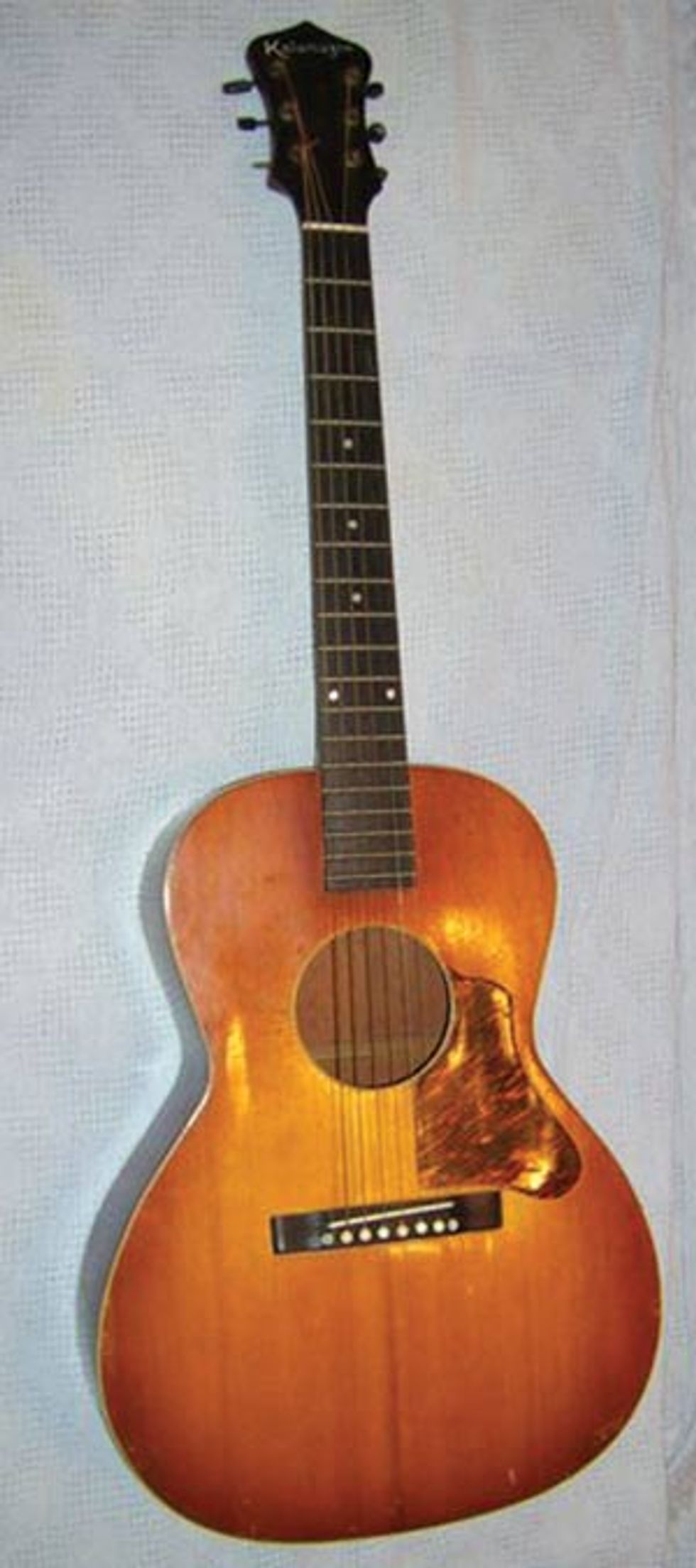Dear Trash or Treasure,
Please find attached pictures of my Kalamazoo guitar. The guitar is a flat top and the stamp on the back of the headstock is FK-220. Could you please estimate the value and provide some information on this guitar?
Thanks!
David Thompson in Jonesborough, TN
 Hey David, thanks for the question! Guy Hart was Gibson’s president between 1924 and 1948, and he is probably best-known for keeping Gibson alive during the Great Depression. Hart was a true businessman, and he didn’t have any prior musical background when he came to work at Gibson. Although Hart wasn’t as innovative as the legendary Ted McCarty (president of Gibson 1948-1966), the Super 400, Gibson flat top acoustics, and Gibson pickups and amplifiers were all developed with Hart as president.
Hey David, thanks for the question! Guy Hart was Gibson’s president between 1924 and 1948, and he is probably best-known for keeping Gibson alive during the Great Depression. Hart was a true businessman, and he didn’t have any prior musical background when he came to work at Gibson. Although Hart wasn’t as innovative as the legendary Ted McCarty (president of Gibson 1948-1966), the Super 400, Gibson flat top acoustics, and Gibson pickups and amplifiers were all developed with Hart as president.
At the beginning of the Great Depression, Hart realized that Gibson would have to produce something cheaper in order to stay in business. In the early 1930s, Gibson started building children’s toys and other wooden items to keep their employees working. Toy making became very successful at Gibson during its short run, but by early 1934, they were back to building instruments full time again. However, Hart also realized that a budget line of instruments was vital to survival. In 1934, Hart introduced the Kalamazoo brand of budget instruments that was named after the city Gibson resided in.
Kalamazoo instruments came in a variety of configurations including acoustic flattops, acoustic archtops, electric Hawaiians, mandolins, and banjos. Although Kalamazoo instruments were built by Gibson, there are several factors that make them different from one another. Kalamazoo instruments featured ladder bracing instead of Gibson’s X bracing, less ornamentation than Gibson, and other cheaper appointments. Most notably, Kalamazoo lacked an adjustable truss rod that has become an important feature in guitar construction these days. Regardless of these features, Kalamazoo instruments were very well-built.
Unfortunately, Kalamazoo instruments often do not have the model name or number stamped anywhere on the guitar, making identification difficult. Kalamazoo only produced two variations of flat top acoustics, so it is a fairly easy process of elimination. Your guitar appears to be a KG-14 that is very similar to the Gibson L-0 in size. Features include a spruce top, mahogany back and sides, a round soundhole with white binding, tortoise top body binding, a mahogany neck, rosewood fingerboard, a rosewood bridge, and a firestripe pickguard. The other Kalamazoo is a KG-11 that has a smaller body with squarer shoulders and a square-topped headstock. Gibson also built a KG-14 in Hawaiian and tenor configurations.
The headstock shape is the best dating feature of the guitar, since Kalamazoo serialization does not follow Gibson’s. The top of your headstock tapers up to a point, placing the date of manufacture between 1938 and 1940. According to your pictures the guitar has been used extensively, and although it is in perfectly fine playing condition, it is still considered “Average” by the Blue Book of Acoustic Guitars grading system. Currently, this guitar is valued between $550 and $700 in the used marketplace.
As the US entered World War II, Gibson decreased production on guitars and focused on other manufacturing projects to aid in the war, which is also when the Kalamazoo brand disappeared. Gibson reintroduced Kalamazoo as another budget brand in 1965 to keep up with the guitar boom of the 1960s. However, these Kalamazoos were mainly solidbody electrics and basses, along with a few guitar amplifiers. Kalamazoo was retired forever in 1970 when Epiphone became Gibson’s budget/ imported line for good.
Kalamazoo instruments were budget brand instruments in the 1930s and 1940s, and today they are only worth a fraction of their Gibson counterparts. Since Kalamazoos were so affordable, many players purchased these guitars and played them a lot. I’ve encountered several Kalamazoo guitars that need work. Whether it is a cracked body, twisted neck, or high action, very few of these guitars are in mint condition today. If you are looking for a Gibson guitar from this era, Kalamazoo is certainly an affordable option. The Kalamazoo line may be trash to some high-end collectors, but it sure is a treasure in many others’ eyes!
Sources: Gibson Guitars, 100 Years of an American Icon by Walter Carter, Gruhn’s Guide to Vintage Guitars by George Gruhn and Walter Carter, and Gibson Amplifiers 1933-2008 – 75 Years of the Gold Tone by Wallace Marx, Jr.
Zachary R. Fjestad
is the author of the Blue Book of Acoustic Guitars, Blue Book of Electric Guitars, and the Blue Book of Guitar Amplifiers. Questions can be submitted to: Blue Book Publications Attn: Guitar Trash or Treasure 8009 34th Ave. S. Ste #175 Minneapolis, MN 55425 800-877-4867
bluebookinc.com
guitars@bluebookinc.com
Please find attached pictures of my Kalamazoo guitar. The guitar is a flat top and the stamp on the back of the headstock is FK-220. Could you please estimate the value and provide some information on this guitar?
Thanks!
David Thompson in Jonesborough, TN
 Hey David, thanks for the question! Guy Hart was Gibson’s president between 1924 and 1948, and he is probably best-known for keeping Gibson alive during the Great Depression. Hart was a true businessman, and he didn’t have any prior musical background when he came to work at Gibson. Although Hart wasn’t as innovative as the legendary Ted McCarty (president of Gibson 1948-1966), the Super 400, Gibson flat top acoustics, and Gibson pickups and amplifiers were all developed with Hart as president.
Hey David, thanks for the question! Guy Hart was Gibson’s president between 1924 and 1948, and he is probably best-known for keeping Gibson alive during the Great Depression. Hart was a true businessman, and he didn’t have any prior musical background when he came to work at Gibson. Although Hart wasn’t as innovative as the legendary Ted McCarty (president of Gibson 1948-1966), the Super 400, Gibson flat top acoustics, and Gibson pickups and amplifiers were all developed with Hart as president. At the beginning of the Great Depression, Hart realized that Gibson would have to produce something cheaper in order to stay in business. In the early 1930s, Gibson started building children’s toys and other wooden items to keep their employees working. Toy making became very successful at Gibson during its short run, but by early 1934, they were back to building instruments full time again. However, Hart also realized that a budget line of instruments was vital to survival. In 1934, Hart introduced the Kalamazoo brand of budget instruments that was named after the city Gibson resided in.
Kalamazoo instruments came in a variety of configurations including acoustic flattops, acoustic archtops, electric Hawaiians, mandolins, and banjos. Although Kalamazoo instruments were built by Gibson, there are several factors that make them different from one another. Kalamazoo instruments featured ladder bracing instead of Gibson’s X bracing, less ornamentation than Gibson, and other cheaper appointments. Most notably, Kalamazoo lacked an adjustable truss rod that has become an important feature in guitar construction these days. Regardless of these features, Kalamazoo instruments were very well-built.
Unfortunately, Kalamazoo instruments often do not have the model name or number stamped anywhere on the guitar, making identification difficult. Kalamazoo only produced two variations of flat top acoustics, so it is a fairly easy process of elimination. Your guitar appears to be a KG-14 that is very similar to the Gibson L-0 in size. Features include a spruce top, mahogany back and sides, a round soundhole with white binding, tortoise top body binding, a mahogany neck, rosewood fingerboard, a rosewood bridge, and a firestripe pickguard. The other Kalamazoo is a KG-11 that has a smaller body with squarer shoulders and a square-topped headstock. Gibson also built a KG-14 in Hawaiian and tenor configurations.
The headstock shape is the best dating feature of the guitar, since Kalamazoo serialization does not follow Gibson’s. The top of your headstock tapers up to a point, placing the date of manufacture between 1938 and 1940. According to your pictures the guitar has been used extensively, and although it is in perfectly fine playing condition, it is still considered “Average” by the Blue Book of Acoustic Guitars grading system. Currently, this guitar is valued between $550 and $700 in the used marketplace.
As the US entered World War II, Gibson decreased production on guitars and focused on other manufacturing projects to aid in the war, which is also when the Kalamazoo brand disappeared. Gibson reintroduced Kalamazoo as another budget brand in 1965 to keep up with the guitar boom of the 1960s. However, these Kalamazoos were mainly solidbody electrics and basses, along with a few guitar amplifiers. Kalamazoo was retired forever in 1970 when Epiphone became Gibson’s budget/ imported line for good.
Kalamazoo instruments were budget brand instruments in the 1930s and 1940s, and today they are only worth a fraction of their Gibson counterparts. Since Kalamazoos were so affordable, many players purchased these guitars and played them a lot. I’ve encountered several Kalamazoo guitars that need work. Whether it is a cracked body, twisted neck, or high action, very few of these guitars are in mint condition today. If you are looking for a Gibson guitar from this era, Kalamazoo is certainly an affordable option. The Kalamazoo line may be trash to some high-end collectors, but it sure is a treasure in many others’ eyes!
Sources: Gibson Guitars, 100 Years of an American Icon by Walter Carter, Gruhn’s Guide to Vintage Guitars by George Gruhn and Walter Carter, and Gibson Amplifiers 1933-2008 – 75 Years of the Gold Tone by Wallace Marx, Jr.
Zachary R. Fjestad
is the author of the Blue Book of Acoustic Guitars, Blue Book of Electric Guitars, and the Blue Book of Guitar Amplifiers. Questions can be submitted to: Blue Book Publications Attn: Guitar Trash or Treasure 8009 34th Ave. S. Ste #175 Minneapolis, MN 55425 800-877-4867
bluebookinc.com
guitars@bluebookinc.com











![Rig Rundown: Russian Circles’ Mike Sullivan [2025]](https://www.premierguitar.com/media-library/youtube.jpg?id=62303631&width=1245&height=700&quality=70&coordinates=0%2C0%2C0%2C0)







